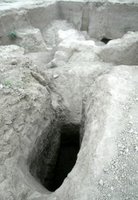Jiroft Relics Dispel Misconceptions

LONDON, 29 January 2006 (CAIS) -- The recent discovery of a head of an admiralty-metal goat statue in a cemetery in the historical site of Jiroft, which dates back to the third millennium BC, led to further interview with the head of Jiroft archaeological excavations, reported CHN.
The director of Jiroft archeological excavations, professor Yousef Majidzadeh pointed out that one of the misconceptions among archeologists and those who believe that Mesopotamia was once a cradle of civilization, is that the artifacts found in the region date back at most to the third millennium BC. Therefore it cannot serve as a cradle of civilization since no relics dating back to the earlier periods were found in this area, he argued.
This is while the latest excavations in the lower layers of the cemetery revealed that the antiquity of the relics discovered in the region dates back to the fourth millennium BC, said Majidzadeh.
“Two types of potteries each from different periods were found in the cemetery, of which one dates back to the fourth millennium BC,“ he noted.
Initially, it was presumed that the region was a cemetery in both periods but studies on the lower layers of the cemetery reveal that the region was a residential area some six thousand years ago, he added.
After a thousand years, the sediments covered the buildings and a cemetery was built over it.
Majidzadeh further stated that geophysical operations undertaken by the French experts indicated that beneath the layer as deep as 11 meters some items may be found.
Archeologists maintain that such a depth signifies ten eras of inhabitation in this area,“ he said.
More than 10,000 wells have been dug in the area by smugglers who have plundered the valuable items in Jiroft, which has been called the ’Lost Paradise’ of archeologists worldwide.

0 Comments:
Post a Comment
<< Home